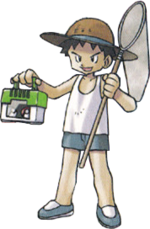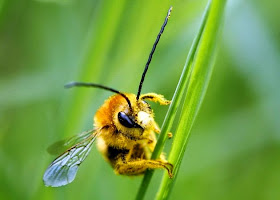Based on the wizard. Just subtract the spells and add all this stuff.
Level 1
Bug Collecting 1
Bug Badges
Save +4 vs Bugs
Level 2
Bug Collecting 2
Bug Buddy
Level 3
Bug Collecting 4
Speak with Insects OR Killing Jar
Level 4+
If you want to expand this class beyond level 3, I wouldn't just increasing the number of bug collected each day (although you could certainly do that). Instead, I'd give them an expanded table of bugs in each ecosystem with d12 different bugs each. Bugs number 11-12 have more powerful effects. Then at level 6, increase it to a d14 table, with two more powerful bugs. Et cetera.
Bugs are insects, spiders, snails, slugs, and limbless worms of all types.
A Save vs Bugs is a save against any effect that originated from a bug, or any effect that is bug-themed.
Bug Collecting
This is how many bugs you can collect--if you have a positive Intelligence modifier, add it. Right before dawn, you can spend an hour gathering this many bugs. At any other time, you can spend 8 hours gathering this many bugs. You cannot collect more than 2x this number of bugs in a given day.
Each ecosystem has a different selection of bugs. Bugs are collected randomly. Each time you get a new bug, enter it in your bug journal. (DMs: Make up a fun fact about each bug.) Once you've collected all 10 bugs in each ecosystem at least once, you get a bug badge.
After being collected, each bug only stays alive (and therefore useful) for the rest of the day. (They're functionally equivalent to spells, in case you were wondering, so this is equivalent to getting a random selection of spells each day.)
Each bug can be used for its effect once, and then the bug either escapes, dies, or is eaten. This really depends on whatever sort of fiction the DM wants to enforce. (But I recommend that nursery spiders should be eaten to gain the effects of spider climb.)
Bug Badges
These are random items that you find near bugs. It might be a half-eaten leaf or a chrysalis. To others, it's just a piece of trash. To you, it is a magic talisman that bestows magical powers. And, you're right! But only while you wear it. However, you can only carry so many bug badges at a time. If you carry too many, you lose the effects of one of your older ones.
You also get mad respect from other bug collectors. The number of bug badges is directly proportionate to the chance that you will have more bug badges than other bug collectors. If you have more bug badges than other bug collectors, you outrank them, and can boss the around.
Bug Buddy
You gain a bug buddy of a type chosen by you (butterfly, beetle, non-poisonous centipede, spider, ant, worm, moth, or fly). This must be a mundane bug without any special powers, no bigger than what you could fit in your (closed) mouth. The bug has Int 3 and obeys you unhesitatingly. It can understand commands of up to two words, optionally pointing to something as well. If your bug buddy dies, you get half the normal XP from this session, and you gain a new bug buddy the next time you go bug collecting.
Speak With Insects
This effect is permanent. Bugs mostly know things related to food and predators. Poisonous insects are sarcastic. Shelled insects are gruff. Worms and caterpillars are naive. Grasshoppers and crickets are jokesters, and are intelligent to provide pleasant conversation partners. Ants are boring. You can also talk to purple worms, who have personalities like furious trucks.
Killing Jar
You can store a bug in a killing jar indefinitely, but only one bug. This lets you "lock" one of your collected bugs (spells), so that it lasts beyond the 1-day expiration date.
I eventually intend to do many different ecosystems. Here are 3.
Ecosystem: Cave
Cave Badge: Treat your falls as if they were 10' shorter.
- Albino Cricket: Gain darkvision for 10 minutes.
- Crocodile Maggot: Summon a giant centipede (HD 1) not under your control.
- Coward Moth: Flies towards the exit.
- Fire Beetle Larva: At some point in the next two hours, you can breath fire. 1d6, 15' cone, save for half.
- Glow Worm: Glows as bright as a torch for 2 hours.
- Mnemobeetle: Learn a full description of a random room in this dungeon, as described by a beetle that has explored it to the full extent that a beetle could.
- Nursery Spider: If eaten, grants spider climb for 10 minutes.
- Pinnate Scolipede: This HD 0 bug (HP 1, AC 10, MV half human, bite is save or die) is highly aggressive.
- Rot Grub: as the classic monster. Becomes "armed" once it leaves your hand.
- Vociferous Cricket: Gain noisy echolocation (60 ft) for 2 hours.
Ecosystem: Forest
Forest Badge: Take half damage from poison. No effect on poisons that don't deal HP or ability score damage.
- Acid Wasp: As acid arrow. Can also be squeezed out, equivalent to a vial of acid.
- Bore Driller: Can be thrown as a ranged attack (20' max). On a hit, deals 2d8 piercing damage.
- Bird Eater: All birds in 50' must save or flee in fear. Non-birds merely get goosebumps.
- Hercules Beetle: Picks up an object not heavier than 2000 lbs and follows you around loyally for 2 hours.
- Pugilistic Parasite: When eaten, will eat all the other parasites that you are currently suffering from. After 1d6 hours of tummyaches, the parasite explodes from your anus and runs away, leaving you with 1 HP.
- Rope Spider: Functions as a grappling hook that shits out a silk thread as soon as it is thrown. The chance of the rope breaking increases to 1-in-6 after 1 day, an increases over the next 5 days.
- Saw Bug: Over the course of 3 rounds, fells a tree in a direction of your choice, or deals 3d6 damage to a plant.
- Scorpion Spider: Can be used to block a doorway with web. If thrown at a flying creature, will attempt to bind its wings, knocking it out of the air if it fails a Strength check.
- Unicorn Fly: Heals 1d6 HP and grants a new save against an ongoing disease.
- Whistling Grub: Incredibly annoying sound. Supernaturally delicious if eaten. Can be used to summon a random encounter. Only applies to random encounters that are interested in eating an incredibly delicious grub-thing.
Ecosystem: Plains
Plains Badge: Save +1 when wearing shorts. You cannot wear shorts with armor heavier than leather.
- Blattoderm: Gives you natural armor equal to plate, with none of the weight. Lasts 2 hours.
- Chaos Cicada: All creatures within 50' that hear this cicada are confused for 1d6 rounds. Save negates.
- Dragon Ant: Can be thrown as a ranged attack (20' max). On a hit, target is incapacitated by pain for 1d6 rounds on a failed save, or 1 round on a successful save. Lingering pain lasts for days.
- Elf Beetle: As faerie fire, when thrown (20' max).
- Jeweled Beetle: Worth 10g. Usually worn as a broach.
- Grimbly Fly: If eaten, grants fly for 1 minute.
- Longfly: Can be used to poison a drink. Poison stays active for 1 hour. Colorless, but tastes salty. If ingested, negates the next spell the drinker attempts to cast. No save.
- Brain Beetle: As ESP for 10 minutes. Additionally, save or fall unconscious for 1d10 minutes.
- Purple Worm Larva: 1-in-6 chance of summoning a purple worm (HD 10) not under your control.
- Zattis Dragonfly. Kicks up dust in a 100' radius.
 |
| this is you |






















